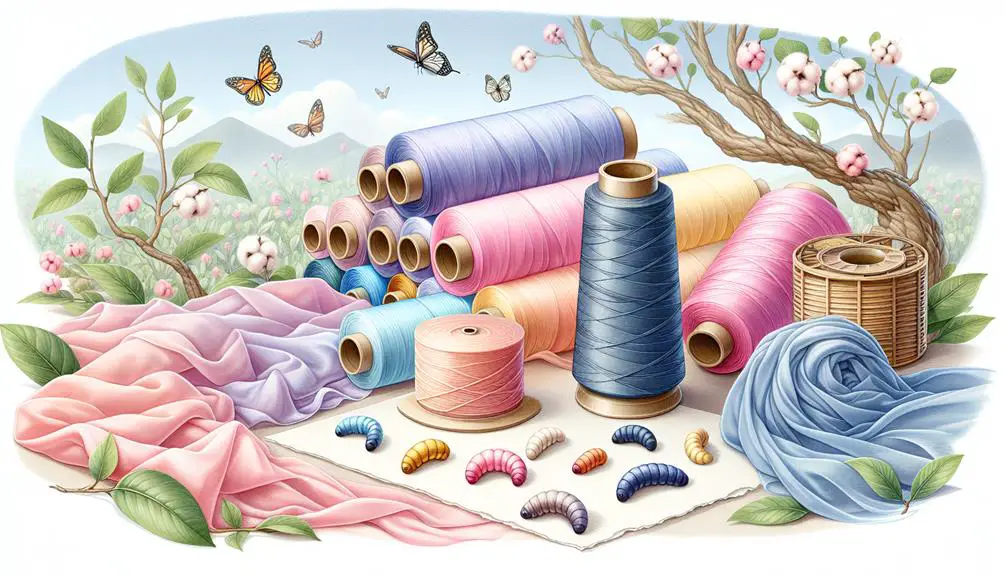I've always been fascinated by chiffon, a fabric that feels as delicate as a cloud. Originally made from silk, chiffon was a symbol of luxury in 18th century France. These days, you'll also find chiffon made from synthetic fibers like polyester, nylon, or rayon. These materials make chiffon more durable and affordable, while still maintaining that soft, sheer quality. Silk chiffon is perfect for airy, elegant dresses and scarves, especially in warm weather since it breathes so well. The synthetic versions are great for robust uses, such as evening wear and lingerie. There's a lot to consider when choosing the right type for your next project.
Table of Contents
Key Takeaways
- Chiffon was originally made from silk, offering a luxurious, lightweight texture.
- Modern chiffon can also be made from synthetic fibers like polyester, nylon, and rayon.
- Silk chiffon is known for its breathability and elegant draping qualities.
- Synthetic chiffons like polyester are popular for their durability and resistance to shrinking.
- Nylon and rayon chiffons are prized for their strength and softness, suitable for various fashion uses.
Origins and History of Chiffon
Though chiffon is popular today, it actually originated back in the early 1700s in France. Initially, it was a luxurious fabric exclusively made from silk. The name itself, 'chiffon,' derives from the French word for 'cloth' or 'rag,' which is somewhat ironic considering its high-end status among fabrics. Back then, chiffon was a symbol of opulence and used mainly by the elite in their extravagant garments due to its sheer, lightweight, and smooth texture.
As the fabric gained popularity, its production began to spread beyond France. By the 19th century, chiffon was being manufactured in other parts of Europe and eventually made its way to America. However, the real game-changer came in the 20th century with the introduction of synthetic fibers. This innovation made chiffon accessible to a broader audience by reducing costs and allowing for easier maintenance and more durable wear.
This shift didn't just democratize the use of chiffon; it also expanded its applications beyond high fashion into more everyday uses, fundamentally changing how people viewed and utilized the fabric. Thus, chiffon's history isn't just about a type of fabric, but about a material that adapted and evolved with time, influencing fashion trends and consumer habits worldwide.
Silk Chiffon: Properties and Uses
While we've explored the rich history of chiffon, let's focus now on silk chiffon and its unique characteristics and applications. Silk chiffon is a lightweight, sheer fabric known for its luxurious feel and elegant appearance. It's made from silk, which provides it with an exceptional softness that's unmatched by synthetic fibers.
One of the standout properties of silk chiffon is its natural sheen and ability to drape beautifully, making it a favorite for flowy dresses, blouses, and scarves. Its slight stretch and delicate texture make it a bit challenging to work with, but that's a trade-off for its lovely finish. It breathes well, making it perfect for warm weather garments.
In terms of uses, silk chiffon isn't just limited to clothing. It's also used in accessories like scarves and wraps, adding a touch of luxury and sophistication. Moreover, due to its translucent quality, it's often layered to create a depth effect in garments, which showcases its rich, vibrant colors and prints.
When you're working with silk chiffon, it's crucial to handle it with care to maintain its integrity and appearance. Always use sharp, fine needles and consider French seams for a clean finish that matches the fabric's elegance.
Synthetic Chiffon Varieties
Moving on from silk, let's explore the different types of synthetic chiffon available in the market. Synthetic chiffons are primarily made from materials like nylon, polyester, and rayon. These fabrics are loved for their durability and affordability, offering a similar drape and sheerness to silk chiffon without the high cost.
Here's a quick breakdown of the most common types:
| Type | Characteristics | Common Uses |
|---|---|---|
| Polyester | Resistant to shrinking and stretching, quick-drying | Evening and bridal wear |
| Nylon | Strong, lightweight, resists wrinkles | Lingerie, blouses |
| Rayon | Soft, absorbent, breathable | Summer dresses, scarves |
Polyester chiffon is the go-to for many because it maintains color well and resists sun damage, making it perfect for vibrant garments. Nylon chiffon is incredibly strong, which is why it's a staple in delicate items like lingerie. Rayon chiffon offers a more natural feel, which makes it ideal for comfortable, breezy outfits.
Each type brings something unique to the table, allowing designers and sewers to choose based on the specific needs of their project. Understanding these options helps you make informed decisions for your own creations or when purchasing ready-made items.
Caring for Chiffon Fabrics
Now that we've explored the different types of chiffon, let's look at how to best care for these delicate fabrics. Caring for chiffon isn't as daunting as it might seem, but it does require a gentle touch. Here's what I've found works best.
Firstly, always check the care label. That's your best guide. If it says dry clean only, I don't mess with that advice. For washable chiffon, I stick to hand washing in cold water with a mild detergent. It's tempting to wring it out, but that can ruin the fabric's shape. Instead, I gently squeeze out the excess water.
After washing, laying the fabric flat to dry is crucial. I avoid hanging chiffon because it can stretch. For drying, I lay it on a clean, dry towel, roll the towel up with the fabric inside to absorb more water, then unroll and lay it flat to finish drying.
Ironing chiffon can be tricky. I set my iron on the lowest heat setting and always use a pressing cloth to protect the fabric. A little steam can help, but direct heat can be disastrous.
With these steps, my chiffon pieces have stayed in great shape, looking as good as new.
Chiffon in Fashion and Decor
Chiffon has effortlessly woven its way into both high fashion and home decor, showcasing its versatility and elegance. In the world of fashion, I've seen it flutter on runways as airy evening gowns and delicate scarves. Its lightweight nature allows it to drape and flow beautifully, making it a favorite for wedding dresses and summer blouses. Meanwhile, in home decor, it's not just about curtains that billow in a gentle breeze—though, I must say, they do add a dreamy quality to any room. Chiffon also makes fantastic accents in the form of throw pillows and lampshades, adding a touch of softness and sophistication.
Here's a quick look at how chiffon stands out in both areas:
| Fashion | Home Decor |
|---|---|
| Wedding dresses | Curtains |
| Summer blouses | Throw pillows |
| Evening gowns | Lampshades |
| Scarves | Table runners |
| Flowy skirts | Sheer decorative pieces |
I've found that this fabric's charm lies in its ability to elevate simplicity. It's about adding that airy, almost ethereal quality to items that could otherwise seem mundane. Whether it's in a chic blouse or a simple window dressing, chiffon adds a layer of elegance that's hard to replicate with other materials.
Frequently Asked Questions
Can Chiffon Be Dyed at Home Effectively?
Yes, I've successfully dyed chiffon at home using acid or reactive dyes, depending on the fabric's composition. It's crucial to follow specific instructions for the dye and fabric type to ensure quality results.
Is Chiffon Fabric Suitable for Winter Clothing?
Chiffon fabric isn't cut out for winter wear; it's too lightweight and doesn't provide enough insulation. I'd opt for thicker materials like wool or fleece to stay cozy during the colder months.
How Does Chiffon Impact the Environment?
Chiffon's environmental impact varies. Synthetic chiffon contributes to microplastic pollution, while silk chiffon raises concerns about resource-intensive production and animal welfare. I'm exploring eco-friendlier alternatives to reduce my fashion footprint.
Are There Hypoallergenic Options for Chiffon?
Just like me, you might be wondering if there are hypoallergenic chiffon options. Luckily, yes! Silk chiffon is naturally hypoallergenic, making it a great choice for those with sensitive skin.
Does Chiffon Offer UV Protection?
I've found that chiffon doesn't inherently offer UV protection. You'd need to treat it with a UV-blocking finish or layer it with other protective clothing to effectively shield yourself from the sun's rays.
- How Does Ring Spun Cotton Affect Garment Fit and Shape Retention? - August 13, 2024
- What Are the Challenges in Producing Ring Spun Cotton? - August 13, 2024
- Is Ring Spun Cotton Suitable for Plus-Size Clothing? - August 13, 2024




